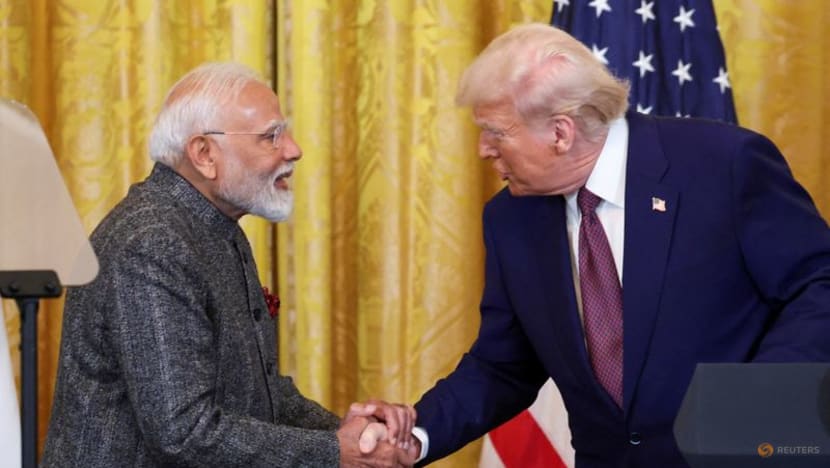Commentary: Modi could get cornered on trade by Trump and his India-Pakistan talk
Washington wants credit for the India-Pakistan ceasefire, but linking truce to tariffs is embarrassing for New Delhi, says Andy Mukherjee for Bloomberg Opinion.

File photo. Indian Prime Minister Narendra Modi and US President Donald Trump shake hands as they attend a joint press conference at the White House in Washington, DC, US, Feb 13, 2025. (Photo: Reuters/Kevin Lamarque)
HONG KONG: Donald Trump has left his friend Narendra Modi with two headaches.
The more severe migraine relates to foreign policy. By rushing to announce that India and Pakistan had agreed to an immediate ceasefire mediated by the United States, the American president exposed the Indian prime minister to criticism at home. Trump has effectively inserted Washington into the Kashmir dispute, something that New Delhi has in the past insisted on discussing only bilaterally with Islamabad.
India’s foreign ministry has responded by saying that there has been no change in its policy, though that can only be tested in future conflicts between the nuclear-armed neighbours. To henceforth have the US treat India and Pakistan as two sides of one big nuclear problem will annul years of diplomatic efforts by New Delhi to carve out an individual space of its own in American foreign-policy imagination.
Modi’s second discomfort concerns politics and economics. Trump has given India’s opposition politicians yet more ammunition by claiming that among all the reasons New Delhi and Islamabad stepped back from the brink of an all-out war, trade was a “big one”.
Even before the 26 per cent reciprocal tariffs (currently suspended), Modi’s opponents were asking why the White House was seeking to punish a country that previous US administrations had been cultivating as a bulwark against China’s rise. Now they want to know why the prime minister is allowing Trump to put economic gains above national security priorities.
Indian officials have denied the suggestion that commerce with the US had anything to do with the truce, though that hasn’t stopped the US president from repeating the claim. On a trip to Saudi Arabia, he added further colour on how he brokered the ceasefire: “I used trade to a large extent. I said, ‘fellas c’mon, let’s make a deal. Let’s not trade nuclear missiles, let’s trade the things you make so beautifully’.”
NO SIGN OF A US-INDIA DEAL YET
Trump is wading into what is delicate economic territory for New Delhi. Washington and Beijing have put their trade war on pause; the US administration has also negotiated a tariff deal with the United Kingdom.
But when it comes to India, which shipped more goods to the US last year than Britain, there is no sign of an accord yet.
Time is of the essence. Apple plans to import most of the iPhones it sells in the US from India by the end of 2026, though Trump seems unwilling to offer even that concession. "I don’t want you building in India,” he told Apple boss Tim Cook in Qatar last week.
Still, less prominent firms in the electronics supply chain may want to lower their dependence on China, provided they have tariff certainty.
Once the moratorium on reciprocal import duties ends Jul 9, most Indian merchandise may face a 26 per cent levy in the US, while those from China will be taxed at a 30 per cent rate. The gap is too small for India to promote itself as a global manufacturing hub.
While the country of 1.4 billion people no doubt has the world’s deepest pool of cheap labour, it’s also notorious for being a hard place to do business.
A HINT TO WASHINGTON?
Indian negotiators are in the US to discuss a bilateral accord. Modi’s need for a quick deal – while protecting vulnerable farmers from US produce – is understood well on the other side.
To give a signal that it won’t be a walkover, New Delhi has told the Word Trade Organization that India reserves the right to respond to the Mar 12 US tariffs on steel and aluminium. But ending US$2 billion of concessions doesn’t change the Modi government’s policy of not starting a tit-for-tat against Trump’s “Liberation Day” tariffs.
The advantage in talks remains with Washington, especially after Trump linked trade to the truce and said that India has proposed to drop all tariffs on US goods. Indian officials have denied making any such offer.
“Terror and trade cannot go together,” Modi said in a televised address after the ceasefire. Since India-Pakistan business is minuscule and declining, the intended recipient of the message must be the prime minister’s right-wing supporters and jingoistic anchors on Indian television: They shouldn’t feel too let down even if the Americans appear to be putting India and Pakistan on an equal footing by dangling the carrot of commerce in front of both.
But if the comment was also a hint to the White House to stop injecting itself into South Asia’s long-running feud, then the suggestion has fallen on deaf ears.
Trump quipped in Riyadh that Modi and Pakistan’s Prime Minister Shehbaz Sharif might as well “go out and have a nice dinner together”. This creates problems for India. As its foreign minister said, bilateral talks with Pakistan can only be about terrorism.
Does the US president not know that his bluster is making the Modi administration look weak? Or is that the goal – to put New Delhi in a corner and force it to wrap up a trade deal advantageous to Washington?
















